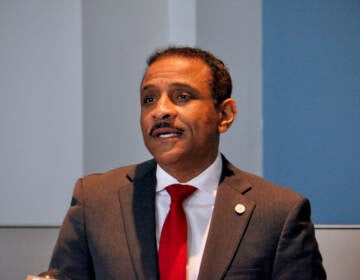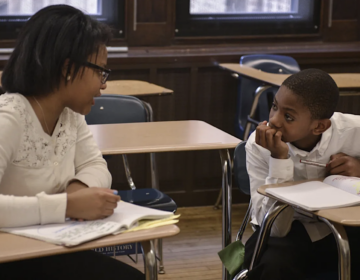Saving Dobson: A story of class, disability, and self-preservation in a Philly school
This is a story of impossible choices, the kind parents and administrators confront daily in a large, poor school district.
Listen 6:15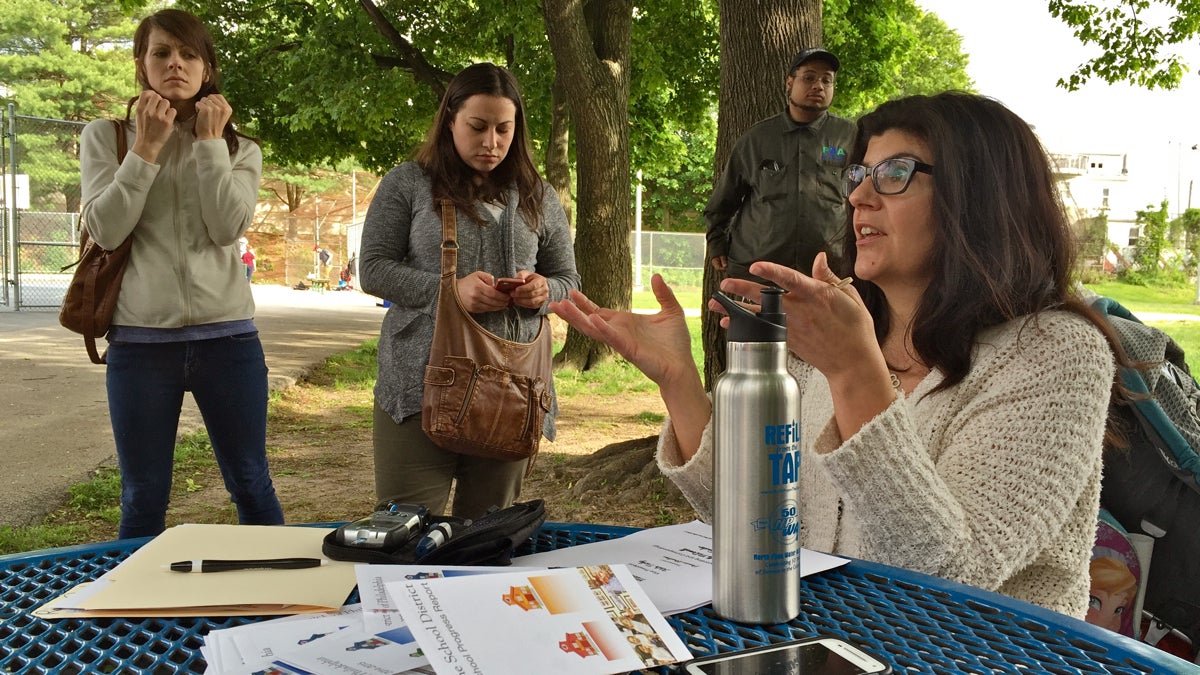
Lauren Perez, as president of the Dobson Home and School Association, led the movement to prevent more special-education students from attending the school. (Avi Wolfman-Arent/WHYY)
What would you do for your kid?
For most parents, the immediate answer is as simple as it is cliched: anything.
Often doing “anything” for one’s child has consequences for other children. Moving to a wealthier school district leaves another district one family poorer. Testing into a magnet school deprives the neighborhood school of a talented youngster. Shelling out for those piano lessons gives your kid a leg up in the college admissions process, but also puts the child who didn’t get lessons at a disadvantage.
Usually these consequences are indirect — or at least indirect enough to avoid real intellectual scrutiny.
That wasn’t the case this year for the parents at James Dobson Elementary, a quiet school of 300 tucked into the hills of Northwest Philadelphia’s Manayunk neighborhood.
In the spring, the parents at Dobson discovered — or thought they discovered — a school district plan to increase the number of special-education students in their building. At first they bristled. Then they raged.
Taking on more special-ed kids would imperil their own children, the parents said. They said it would ruin Dobson’s reputation and drive young families out of the neighborhood.
Once mobilized, the parents made a bold request. They asked the School District of Philadelphia to restrict the number of special-education students at Dobson; they asked, essentially, for special treatment.
And in the end, they may just have gotten it.
This is a story of impossible choices, the kind parents and administrators confront daily in a large, poor school district.
Should a group of parents slam the door on vulnerable, but troubled students? Or should they welcome all comers, even if it might harm their own children?
Should a school district scrapping to keep parents in the city bend to the demands of those parents? Or should it ignore their complaints, perpetuating every stereotype of the disconnected bureaucrat?
What would do you for your kid? What should you do?
A school budget, an extra teacher, and a theory
Our story begins in April at one of those sleepy school-community meetings attended only by a handful of the most committed parents. This particular gathering, held inside Dobson’s library, was on the subject of the 2016-17 school budget.
While scanning the budget document, Lauren Perez, then head of Dobson’s Home and School Association, noticed an aberration. There was an extra special-education teacher in the budget. Specifically, there was an extra instructor assigned to teach “emotional support” students.
School districts must provide emotional support — or ES services — to students classified as emotionally disturbed. This isn’t a clinical designation, but rather one of 13 categories of disability as defined by the federal law governing special-education services.
To qualify as emotionally disturbed, a student must exhibit behavior problems severe enough to hinder his or her ability to learn. This can include students so introverted and socially disengaged it hurts their schoolwork.
But it typically doesn’t, says Daniel Cooper, an attorney who represents special-education students and their families in the Philadelphia area.
Instead, said Cooper, most students labeled emotionally disturbed receive that designation because they act out. Emotionally disturbed students are, Cooper said, “kids that will tear up classrooms, be physically aggressive, hit other students, hit their teachers, [and be] verbally aggressive to the point where they’re cursing out other kids, cursing out other teachers.”
One mother of an emotionally disturbed student at Dobson described her daughter as bright but volatile. The mother, who would not allow WHYY to use her name, said her daughter loses control of her emotions at school 18 to 20 times a month. The episodes range from verbal dust-ups to flipped desks and pencil stabbings. After the outbursts are over. She said her daughter often feels remorse, going so far as to write letters of apology. But still the behavior problems persist.
“She’s not bad,” the mother said. “She’s very sweet. Some kids know how to deal with their emotions. Some kids don’t. Not everybody is the same.”
For families of emotional support students, finding a good academic fit can be an arduous process. The mother of the Dobson student said her daughter had been through four district schools by sixth grade. Another family in Kensington described a similar carousel of schools, all in pursuit of the most supportive environment. It is painful, the mother of the Dobson parent said, to feel her child’s future slipping away because of recurring behavioral issues.
“I worry about her not being able to go to college because she’s not getting the proper education,” she said. “It takes a toll on her and her teachers, as well.”
Emotional disturbance is a rare disability. Only 1,557 students in Philly’s public schools require emotional support. District practice mandates that emotionally disturbed students go to the closest local school that has a dedicated emotional support program. Dobson, one of those schools, is a hub for students from the neighborhood and beyond who need those services.
In 2015-16, Dobson had 305 students in grades kindergarten through eight. Twelve of them were classified emotionally disturbed. These students receive some pull-out time in a separate class where they work on social skills and set goals, but spend much of their school day alongside general-education peers.
In prior years, Dobson’s emotional support program covered only students in grades three through five. Perez noticed, however, that the 2016-17 school year budget included an emotional support teacher for grades six through eight.
What would have looked like a good thing to most — hooray, another teacher — looked like a threat to Perez. It meant emotionally disturbed students that would have had to leave Dobson after fifth grade could now stay through the eighth. That, in turn, meant Dobson would take on more emotionally disturbed students, Perez figured.
And this, to her, was a major problem.
‘I am NOT saying I don’t want ANY of these special-education students’
Throughout the year, parents complained that the current crop of emotionally disturbed students at Dobson were causing trouble. They described fights, wild outbursts, assaults on teachers — in essence a school on the brink of breakdown. (Dobson teachers and administrators contacted for this story either redirected questions to the school district’s central office or didn’t reply to requests for interviews.)
In a May letter to Sonya Berry, special-education director for the region, parent Denisa Bratina said “potentially violent” students at Dobson were “being protected from reasonable consequences” and that the school was suffering as a result. The pleading in her letter captured much of the mood among the most upset parents.
“I am NOT saying I don’t want ANY of these Special Education students,” Bratina wrote. “Of course, everyone deserves an education. What I AM saying is that overloading one school with a % exceeding double that of successful schools, and subsequently not providing basic supports like STAFF, DOES NOT SERVE THE STUDENTS. Being set up to fail is UNACCEPTABLE.”
Bratina, the mother of a special-education student, is a longtime Manayunk resident whose grandmother attended Dobson almost a century ago. She and others felt their beloved school was under siege. Adding more emotionally disturbed students, they argued, would tip Dobson into full-fledged chaos.
“I feel like this is the most important thing that we’ll ever do for our school,” said Perez in mid-May. ” And if we don’t stand together and stick together on it, then we’re giving up our school. It’s out of our hands. It’s no longer our school. It’s their school — because the district decided they could put in our school whoever they wanted.”
A typical middle-income school, with one exception
James Dobson Elementary belongs to the narrow set of city schools that have reasonably high test scores, aren’t special admission, and aren’t located in the priciest enclaves of Center City. It sits in a census tract where the median family income is double the city average. The average owner-occupied home in Dobson’s backyard goes for $228,000 — pricey by Philadelphia standards, but within reach for a middle-class family.
The school demographics offer a balanced mix of black and white, privileged and poor. It’s small. It’s homey. It is, as the members of the Home and School Association would later describe it in an online petition, a “community gem.”
“I know your kids. Your kids know my kids. It’s really tight-knit. It’s like a really small town inside of a big city,” said parent Melissa Copeland.
Dobson profiles like a typical middle-class city school in almost every way except one: its special-education population.
At Dobson, 4.1 percent of students are emotionally disturbed. That may not seem like much, but it’s well above the school district average of 1.2 percent. Out of 220 district schools, Dobson has the 20th highest percentage of emotionally disturbed children.
Other schools with student bodies similar to Dobson don’t have anywhere near this number of emotionally disturbed students.
To make this point, Dobson parents circulated statistics showing that their school had a higher-than-average proportion of special-education students. The same document showed that the city’s highest performing elementary schools — mostly located in Philadelphia’s ritziest neighborhoods — have a lower-than-average proportion of special-education educations. Why, they wondered, couldn’t their school have those types of demographics?
The Dobson parents didn’t have access to a school-by-school breakdown of emotional support students. But those numbers tell a similar story.
There are only 18 schools in Philadelphia that serve a lower percentage of economically disadvantaged students than Dobson. Together those 18 schools enroll 14,220 students, just 28 of whom are emotionally disturbed. That’s a minuscule 0.2 percent.
Dobson has 12 such students in a school of 290.
| SCHOOL | % ES STUDENTS | % ECONOMICALLY DISADVANTAGED |
| William Meredith | 0.00% | 17.41% |
| Albert Greenfield | 0.00% | 17.93% |
| Joseph Greenberg | 0.00% | 23.85% |
| Penn Alexander | 0.00% | 24.46% |
| Julia R. Masterman | 0.17% | 24.6% |
| Science Leadership Academy | 0.20% | 27.86% |
| GAMP | 0.17% | 31.76% |
| J.S. Jenks | 0.21% | 34.74% |
| Arts Academy at Benjamin Rush | 0.33% | 34.91% |
| Central High School | 0.00% | 39.80% |
| Stephen Decatur | 0.10% | 41.63% |
| Watson Comly | 0.00% | 42.06% |
| CAPA HS | 0.28% | 43.02% |
| SLA at Beeber | 0.84% | 43.53% |
| Shawmont | 0.00% | 44.25% |
| High School of Engineering and Science | 0.11% | 44.74% |
| Baldi MS | 0.94% | 45.13% |
| Fox Chase School | 0.00% | 46.84% |
| James Dobson | 4.14% | 47.40% |
| C.W. Henry | 0.21% | 47.50% |
In other words, emotionally disturbed students are nearly impossible to find at middle-income schools — with the one exception of Dobson.
(By the way, the reverse is also true. Of the 20 schools with the highest percentage of emotionally disturbed students, 16 serve a higher than average proportion of students in poverty.)
That’s not a coincidence, said Daniel Cooper, the special-education attorney. Research shows that students with emotional disabilities disproportionately come from poor families. Students in the child welfare and foster care systems are also more likely to need emotional support services.
“Emotional disturbance has significant, significant environmental factors,” said Cooper. “I’ve had kids who have witnessed all sorts of horrific, horrific violence. That is going to lead to mental health issues.”
Emotionally disturbed students don’t behave poorly out of malice, but there is a growing and uncomfortable body of evidence that suggests students with emotional issues can negatively affect the mental well-being and academic achievement of their classmates.
Recent studies suggest that when general-education students share a room with special-education students, test scores drop and absenteeism rises, said Michael Gottfried, associate professor of education at the University of California, Santa Barbara.
There are a number of possible explanations, said Gottfried. Special-education students may disrupt classroom flow or they may just take up more of the teacher’s time, leaving other students to languish. What’s clear, he said, is that the “spillover effect” is particularly pronounced when students share a class with children who are emotionally disturbed.
“Research shows that students with emotional disabilities are actually the hardest to incorporate in the general classroom,” he said.
The parents at Dobson intuited much of this. They sensed the unusually high number of emotional support students would make things more difficult for their children. Adding more of these troubled students would only make matters worse.
In essence, Dobson was a middle-income school dealing with a poorer school’s problem.
“These kids are coming from such traumatized backgrounds. Our kids are not used to that level of trauma. They’re just not.” said Perez. “Diversity, does it have to mean that?”
‘My kid comes first’
Soon after Perez noticed the new special-education teacher in the budget, she and other parents mobilized. The Home and School Association drafted an online petition calling on school district leaders to address the “inequitable” number of special-education students at Dobson. It quickly attracted 180 signatures.
In early May, about 75 parents met with a group of high-level district administrators, but left disappointed. They described the officials as a row of nodding heads, conveniently unable to answer their questions or explain why Dobson was in its current predicament.
Frustration peaked at an unusually well-attended meeting of the Home and School Association later that month. After hurdling through reports on the usual items — bake sales, fundraisers, and the like — Perez opened the floor to concerns about special education.
Like a match striking gasoline, grievances spread quickly around the circle of parents.
Parents called the emotionally disturbed students dangerous and uncontrollable. One accused them of using foul language her kids weren’t used to hearing, while another made a vague reference to bad “influences on the playground.” Perez accused the district of converting Dobson into a citywide hub for special-education students.
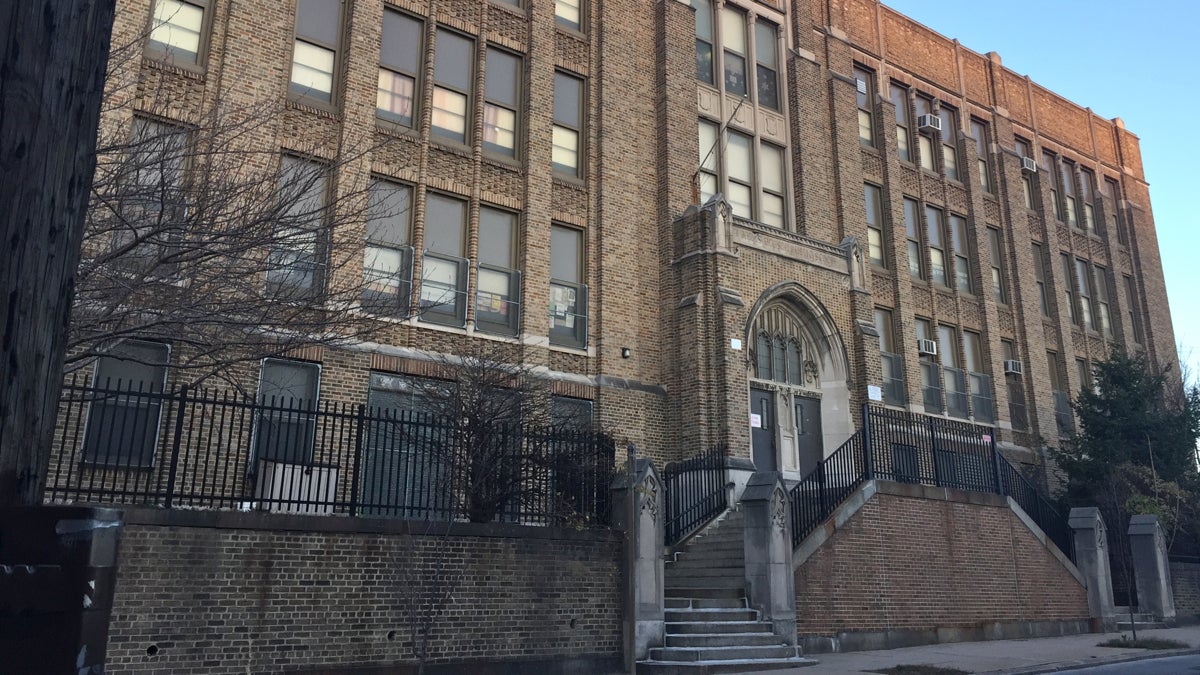
Dad William Copeland talked about Charles Drew, the school in West Philadelphia he attended as a kid. The school was chaotic. He couldn’t learn. Eventually his parents pulled him out.
“Any school in Philadelphia, in my opinion, can turn into that,” he said.
Even Dobson?
“If you put bad kids in there, yeah,” he said. “Can’t do nothing ’bout that, if you’re forced to take horrible children from anywhere.”
The logic here is simple and cold. Emotionally disturbed kids are problem kids. Too many problem kids and your school becomes a “bad” school. And no one sends their kids to a bad school — so long as they have the money and resources to avoid it.
Dobson parent Denise Bratina punctuated this point by pointing her finger west toward the city border.
“Montgomery County is literally right there,” she said. “I have dozens of friends who have moved to the suburbs because they don’t wanna send their children to Philadelphia public schools. Philadelphia public schools have a bad rap.”
Manayunk, said Perez, was the only neighborhood where she could afford a house with a front-yard vegetable garden, send her kids to the local public school, and still bike to work downtown. In a city and a school system like Philadelphia, those kind of specs are hard to find.
“Everyone keeps saying, ‘I’m going to move out,'” said another parent, Dena Stefenak. “I’m going to put up a really good fight.”
Asked whether any of this felt callous — whether slamming the door on special-needs students might trigger some guilt — Stefenak responded softly, but firmly.
“My kid comes first,” she said. “I’m sorry. I care about everyone’s kid. But mine’s first.”
A final meeting with an uncertain conclusion
By the time June rolled around, Perez had forced district officials to meet with her twice and conduct an audit of the building to make sure it wasn’t overcrowded. It wasn’t. In fact, Dobson was found to be under capacity.
Finally, in early June, the district held a third meeting with parents. And the story ends here. But it’s hard to tell exactly how it will conclude.
In Perez’s version, at this final meeting, the district consummated a wink-wink deal with the parents that was first discussed by phone in May. Administrators said Dobson would continue to serve all the emotional support students currently at the school, and would, as budgeted, get a second emotional support teacher to help handle the caseload.
Most important to the parents, Perez says, the district promised not to add any new emotionally disturbed students from outside the neighborhood — even though Dobson is technically supposed to be a regional hub for students with emotional disabilities.
“They helped us,” Perez said. “They did. They did.”
The district vehemently denied this version of events, saying it made no such promise. Natalie Hess, who oversees special education for the district, said officials told the parents that there was never a plan to add more emotional support students. The new teacher was simply a way to keep students in the building as they finished out their elementary years. It meant nothing more and nothing less.
“I think that we have been able to explain that we are providing the service and support that the students who are currently enrolled in the building need and require,” Hess said. “And that we’re not looking to fill the school with emotional support students, but rather serve the population at hand.”
Through a right-to-know request, WHYY obtained emails sent among district officials about their actions at Dobson. The emails appear, at least on some level, to support Perez’s account of events.
According to the emails, district officials told Dobson parents that their school did have room for more students. Despite this, district officials said they’d try to ensure the school didn’t take on any more special-education student from outside its immediate catchment area (the geographic area from which it normally draws students).
In an email sent to colleagues and dated May 24, assistant superintendent Karen Kolsky recapped a phone call with Perez and said, “We also explained that the school is under-enrolled. Class size is small. We also stated that the District will make efforts to only have catchment students in the school both spec[ial] ed and gen[eral] ed.”
Before a final meeting with parents in early June, Kolsky reiterated in an internal planning memo marked urgent that the district “will certainly strive not to place any out of catchment ES students at Dobson.”
It’s unclear how the district would change enrollment patterns to keep emotionally disturbed students who live outside Manayunk from attending Dobson or what schools might be affected by the shift.
The district said in a statement that it had added one student to the emotional support program at Dobson in 2016-17 and provided the extra teacher to allow ES students who start at Dobson in the early grades to remain through eighth. The district did not say whether the one student added to Dobson’s ES program this school year was from outside the school’s catchment area.
Through spokesman H. Lee Whack, the district issued the following statement:
“The District in fact did monitor placement requests for emotional support students in the area of the city where Dobson is located. While no additional student was added to the program for the remainder of the 2015-2016 school year there were additional students added to the emotional support programs at Dobson this year. Since the beginning of the 2016-2017 school year there has been one additional student added to the emotional support programs at Dobson. The District is focused on serving the needs of neighborhood students and other students within the area, across age groups, while being mindful of the overall school population. The bottom line is we are focused on making sure all children in Philadelphia get a quality education close to where they live.”
The district said it’s received no major complaints this school year related to the emotional support program at Dobson. Perez said she and the other parents are satisfied with the current situation and what they see as the district’s promise to restrict the number of emotionally disturbed students at Dobson.
Despite the district stating otherwise, Perez is certain she and the parents forced the school district to bend the rules.
But she isn’t happy about what she’s done. Relieved? Maybe. But not happy.
“I mean, I don’t feel good about it,” Perez said. “That’s why this stuff, that’s why these victories they’re not really …”
She trails off, but it’s not hard to fill in the blank. She feels guilty. And to some it may appear she’s a meddling middle-class mom who pawned her problems off on somebody else.
But Perez’s story is more complicated than that.
Epilogue: ‘Someone’s always going to get hurt’
A little over seven years ago, Perez got a call from her sister, who’d recently had a child she was unable to care for. Perez was already a single mom living in Port Richmond, a working-class section of Northeast Philadelphia. She was waiting tables to get by, and hardly had the income or time to take on another child.
Yet, when her sister asked if she could take the infant in, she felt obligated to say yes. The boy’s name was Hunter and he had type 1 diabetes. Perez fretted constantly over what might happen if she botched his care.
“They give you this kid and they’re like, ‘Here’s this insulin that you inject into them. And, oh by the way, you can give them too much and they’ll go into a coma,'” Perez said. “And you have to be like, OK.”
Over the next year, her life started to unravel. She missed shifts at work. She got fired. She was consumed by worry.
“That was a hard time. Really, really tough,” she said. “One of the things that is a constant for me is that nothing ever stays that way.”
Eventually Perez met a guy on Match.com, a carpenter named John. Within a couple months of dating, Perez asked if they could move in together and get a house. She was desperate. Miraculously, he said OK. They picked Manayunk because Dobson is a good enough school. And the houses are affordable enough. And after a couple years running around, trying to survive, she thought “this is a place I can set down some roots.”
“If I could get the school to be a school that parents would move to Manayunk [for], they’d buy the houses,” Perez said. “All my problems would be solved.”
To Perez, Dobson wasn’t just a school. It was like her version of Oz — a place of promise at the end of this grinding journey. And so the prospect of Dobson losing prestige after she’d hinged so much of her future on it felt unbearable.
“I wouldn’t have to do any of this,” she said. “I could just tend to my garden. And raise my kids and let them go to a sh***y school. I wouldn’t have to do any of this! And for me personally, for my personal story, it’s kinda like a real kick in the pants don’t you think? After all that.”
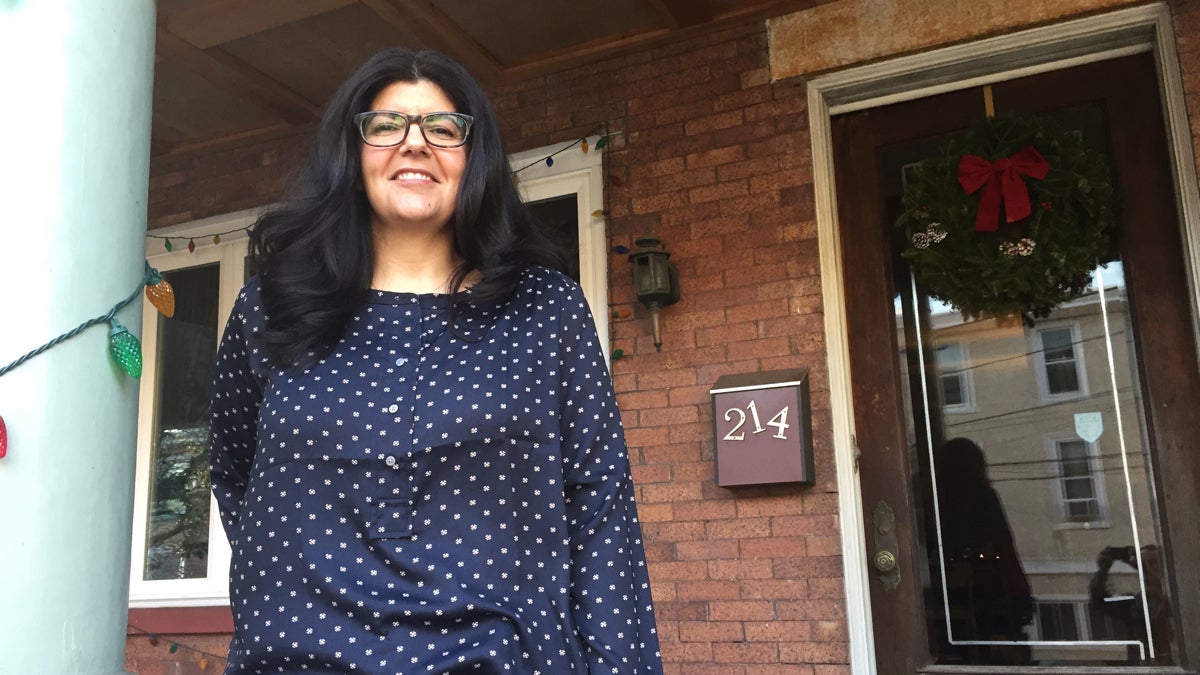
Perez knows if special-ed kids didn’t wind up at Dobson, they aren’t going to disappear. But the way she sees it, that’s just life in an urban school district. You fight for your little patch of adequacy. And say to yourself, that’s good enough.
“It’s like you can’t think of every person that died making your jeans, you know? You can only do as much as you can do,” she said. “Someone’s always going to get hurt. Always.”
Hunter’s birth father died in October. His birth mom lives in Georgia, Perez said.
He could be in the foster system, perhaps experiencing the exact sort of tumult and trauma that leads some children to develop emotional disabilities.
Yet, on a recent Friday, Hunter bounded through the door of a handsomely kept home in Manayunk, cheeks rosy from the cold. His sweatpants bore the name of the elementary school he now attends in this safe and stable part of the city.
He’s there because someone fought for him. And she’s still fighting.
WHYY is your source for fact-based, in-depth journalism and information. As a nonprofit organization, we rely on financial support from readers like you. Please give today.




